
Thelesperma filifolium, commonly known as stiff greenthread, or plains greenthread, is a species of flowering plant in the aster family, Asteraceae. It is often found growing in shallow soils. It prefers disturbed sites in dry, sandy or gravelly soil with a neutral to basic pH. Stiff greenthread adapts to various soil conditions, including loam, clay, caliche, and roadsides. It blooms between March and June and often into the fall.

Grindelia squarrosa, also known as a curly-top gumweed or curlycup gumweed, is a small North American biennial or short-lived perennial plant.
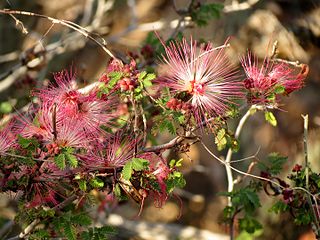
Calliandra eriophylla, commonly known as fairy duster, is a low spreading shrub which is native to deserts and arid grasslands in California, Arizona, New Mexico, Texas, and Mexico.

Castilleja angustifolia is a species of wildflower known by the common names northwestern Indian paintbrush and desert Indian paintbrush. It is an herbaceous perennial native to the desert, scrublands, and woodlands of western North America. It grows in hot sandy soils and rock crevices in dry conditions.
Dalea mollis is a species of flowering plant in the legume family which is known by the common name hairy prairie clover.

Dalea mollissima is a desert wildflower plant in the legume family (Fabaceae), with the common names soft prairie clover, downy dalea, and silk dalea.

Dalea albiflora, the whiteflower prairie clover or scruffy prairie clover, is a perennial subshrub or herb of the subfamily Faboideae in the pea family-(Fabaceae). It is found in the southwestern United States and Northwestern Mexico in the states of Arizona, New Mexico, Sonora, and Chihuahua.

Astragalus bernardinus, known by the common name San Bernardino milkvetch or the Lesser Three-keeled Milkvetch, is a species of milkvetch. It is a plant of desert and dry mountain slope habitat. It is native to California.
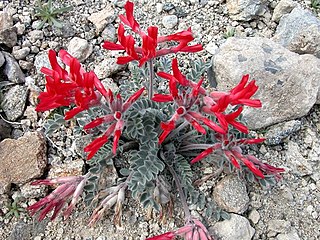
Astragalus coccineus is a species of milkvetch known by the common name scarlet locoweed or scarlet milkvetch. It is native to the deserts, scrub, and chaparral of the Southwestern United States in Arizona, California, and Nevada, and in northwestern Mexico.

Dalea candida is a species of flowering plant in the legume family known by the common name white prairie clover. It is native to North America, where it can be found throughout central Canada, the central United States, and northern Mexico. It can sometimes be found outside its range as an introduced species. It grows in many types of habitat, including several types of prairie, foothills, woods, forests, and disturbed areas.
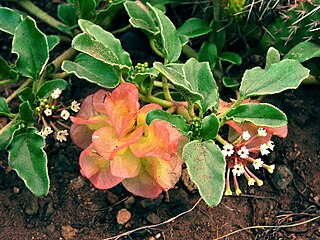
Tripterocalyx micranthus is a species of flowering plant in the four o'clock family known by the common names smallflower sandverbena and small-flowered sand-verbena.
Prunus eremophila, also known by its common name Mojave Desert plum, is a rare species of plum native to California.
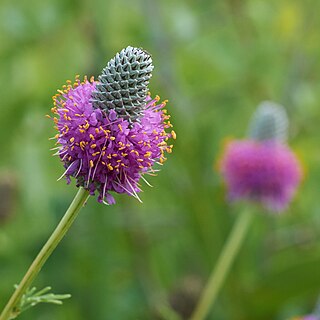
Dalea purpurea is a species of flowering plant in the legume family known as purple prairie clover. Native to central North America, purple prairie clover is a relatively common member of the Great Plains and prairie ecosystems. It blooms in the summer with dense spikes of bright purple flowers that attract many species of insects.

Astragalus amphioxys, common name crescent milkvetch, is a plant found in the American southwest, including the whole of Utah, the southeast part of Nevada, the north part of Arizona, the western part of Colorado, the northwestern part of New Mexico, and one county in Texas. It was first described by Asa Gray in 1878.
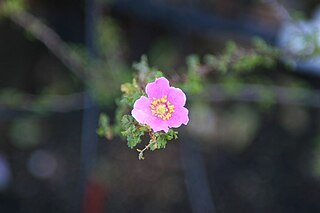
Rosa stellata is a species of rose known by the common names desert rose, gooseberry rose, and star rose. In Texas this type of rose grows on dry rocky places to 6,500 feet (2,000 m), such as the Trans-Pecos. It occurs in the mountain canyons of Arizona and New Mexico. It also grows in dry, rocky places. It has trifoliate leaves, deep rose purple blossoms and yellowish white prickles on the petioles and stems. It is a perennial shrub with velvety, deciduous leaves. Some horticulturists consider it to be a browse plant.
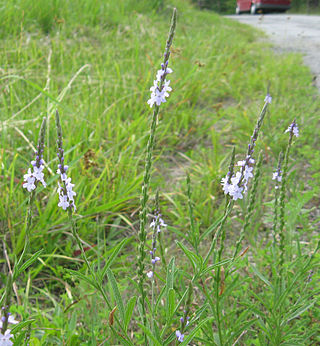
Verbena simplex, commonly known as narrowleaf vervain, is a perennial herbaceous plant in the Verbenaceae (vervain) family. It is native to central and eastern North America where it is found in open, dry, habitats on calcareous soil. It produces lavender flowers in the summer.

Melampodium leucanthum, the plains blackfoot or blackfoot daisy, is an herbaceous perennial plant in the family Asteraceae found on rocky slopes in the southwest U.S. It is an attractive ornamental, blooming from March to November.

Dalea aurea, commonly called golden prairie clover, is a species of flowering plant in the legume family (Fabaceae). It is native to North America, where it is found in the Great Plains and southwestern United States, and in the state of Coahuila, Mexico. Its natural habitat is in silty or gravelly prairies, often over limestone.

Dalea multiflora, commonly called roundhead prairie clover, is a species of flowering plant in the legume family (Fabaceae). It is native to North America, where it is found in Mexico and the United States. In the U.S., it is primarily found in the Great Plains and South Central regions. Its natural habitat is in dry rocky prairies, particularly in limestone soils. It is a conservative species and can be indicative of undisturbed prairie communities.
Psorothamnus scoparius is a thornless bush in the bean family (Fabaceae), native to North America. It is known as broom smokebush and broom dalea.


















